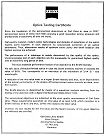|
|
|||||||||||
| Presentation and Philosophy | |||||||||||
|
The Zeiss Telementor refractor was beautifully made in Jena, Germany. The Zeiss workers took an enormous pride in their company's name, and would never allow anything substandard to leave the factory. They had to contend with shortages of basic components, such as screws, bolts and so on while under the communist regime in the old DDR. Whenever necessary, they would even resort to manufacturing their own screws. In this way, they were able to maintain the high construction quality for which the Telementor and other Zeiss products were justly famous. The reward of these faithful and loyal company servants?. After the reunification of Germany, the Zeiss company was also reunited. Probaby, the eastern workers (or many of them) lost their jobs in the process. A rather sad story, we are afraid. The small Zeiss Telementor will only ever be a 2.5-inch refractor, of course. But it is in no way comparable to the commonplace 2.4-inch instruments that have given such a bad name to small refractors. It is absolutely superb - a solid, heavy telescope of stunning optical and mechanical quality, despite its old-fashioned design. No "whistles and bells", not even a motor drive. But many owners fall in love with them and would not part with theirs "for a big clock", as they say in Liverpool. It is the ideal small instrument for double-star observing and solar observation, and gives astonishing views of the moon and planets for an instrument of such a small aperture. Really, a Zeiss Telementor is something to be experienced, but we must tell here a word of caution, it's an "infecting" telescope. That is, after using it, you suffer a permanent condition that makes you use it more and more, sometimes putting your other scopes to sleep for a while (or forever, your mileage can vary :). About the optical quality of the scope, on the intra and extrafocal images on stars, we can't say they are textbook. It's better to say textbooks were written and drawn after observing the images through a Telementor!. Mechanics are outstanding and again at optical performance, some users are actually making some lunar and solar astrophotograhpy with a digital camera. Let us quote what Tim Leese, a very experienced amateur Astronomer from Northwich, England, has recentely written with respect to some Moon pictures you can enjoy in these pages: I
like, very much, the photo
of the moon taken with a Zeiss Telementor.
I
For those who like to put facts into technical perspective, let's make some math. From the book "Telescope Optics" (Rotten & Van Venrooij), we can see that a refractor meets "achromat" standards when it verifies the following equation: f = 0.122 x D [1] Where f is the focal ratio of the refractor and D its aperture in milimetres. Hence, a classic, very good refractor such as a Japan made achro 102mm would need at least a focal relation of 0.122 x 102 = 12.44. Since that scope has a f/9.8 focal relationship, it theoretically doesn't seem to meet the conditions for "achromat standards". Even so, in our experience, color correction is excellent for that fine refractor. Let's see what happens with the Telementor (don't forget it was officially classified by Zeiss as "achromat"). For 63mm aperture we have: f = 0.122 x 63 => f = 7.68 So for 63mm aperture, we would need only a f/7.68 system. But the Telementor is a f/13.33 scope, so just imagine!. Only for handling more "traditional" figures, let's change the last expression and then let's apply it to a 4 inches refractor. Given f=13.33 and D=63 in [1], we can write: 13.33 = k . 63 Applying this value to [1] we would have for a 4" refractor: f = 0.2116 x 102 => f = 21.58 So, for a 4" refractor having the same level of color correction of a Telementor, we would need to have an almost f/22 system, yielding a focal lenght of about 2,200 milimeters!!. This provides a level of color correction really close to a modern Apochromat refractor. Complementing this, laser interferometry expresses the quality of the lenses rather well: One member of the Telementor Group analyzed his small Zeiss yielding the following figures: PV: 1/7.1 lambda
This is no surprise since Zeiss guaranteed every refractor from Jena being at least 1/28 lambda with a Strehl intensity of 95% or better (click here to see a Zeiss Optics Testing Certificate provided by Zeiss user PJ Anway). These exigent quality control procedures can only be implemented when a company manufactures superb products. This Website is in some way a tribute to the Zeiss Jena Firma in general and the Zeiss Telementor scope in particular. We try to build this site for every Telementor user and those interested in adquiring one without forgetting a compromise in quality contents. If you own a Telementor, or another Zeiss scope, please, don’t hesitate to contact us. Freude durch beobachten,
|
|||||||||||

